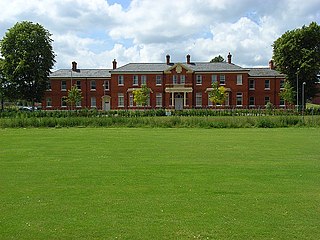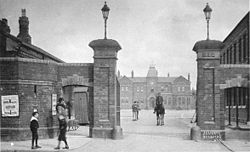
The Australian Army is Australia's military land force. Formed in 1901 through the amalgamation of the Australian colonial forces following federation, it is part of the Australian Defence Force (ADF) along with the Royal Australian Navy and the Royal Australian Air Force. While the Chief of the Defence Force (CDF) commands the ADF, the Army is commanded by the Chief of Army (CA). The CA is therefore subordinate to the CDF, but is also directly responsible to the Minister for Defence. Although Australian soldiers have been involved in a number of minor and major conflicts throughout Australia's history, only during the Second World War has Australian territory come under direct attack.

The Royal Regiment of Artillery, commonly referred to as the Royal Artillery (RA) and colloquially known as "The Gunners", is the artillery arm of the British Army. The Royal Regiment of Artillery comprises thirteen Regular Army regiments, King's Troop Royal Horse Artillery and five Army Reserve regiments.
The Officers' Training Corps (OTC), more fully called the University Officers' Training Corps (UOTC), are military leadership training units similar to a university club but operated by the British Army. Their focus is to develop the leadership abilities of their members whilst giving them an opportunity to take part in military life whilst at university. OTCs also organise non-military outdoor pursuits such as hill walking and mountaineering. UOTC units are not deployable units nor are their cadets classed as trained soldiers. The majority of members of the UOTC do not go on to serve in the regular or reserve forces.

The Highlanders, 4th Battalion, Royal Regiment of Scotland is an infantry battalion of the Royal Regiment of Scotland.

The Scottish Division was a British Army Infantry command, training and administrative apparatus designated for all Scottish line infantry units. It merged with the Prince of Wales' Division, to form the Scottish, Welsh and Irish Division in 2017.

The Royal Artillery Barracks at Woolwich in the Royal Borough of Greenwich, London, was the home of the Royal Artillery from 1776 until 2007.

Seaforth is a district in the Metropolitan Borough of Sefton, Merseyside, England. Historically in Lancashire, it is north of Liverpool, between Bootle and Waterloo.

The Royal School of Artillery (RSA) is the principal training establishment for artillery warfare in the British Army. Established in 1915, it is located at Larkhill, Wiltshire, on the south edge of Salisbury Plain in the United Kingdom. The School is the primary training facility for Royal Artillery recruits, and is also home to the Gunnery Training Team.

Larkhill is a garrison town in the civil parish of Durrington, Wiltshire, England. It lies about 1 3⁄4 miles (2.8 km) west of the centre of Durrington village and 1 1⁄2 mi (2.4 km) north of the prehistoric monument of Stonehenge. It is about 10 mi (16 km) north of Salisbury.

A Scottish regiment is any regiment that at some time in its history has or had a name that referred to Scotland or some part, thereof, and adopted items of Scottish dress. These regiments were created after the Acts of Union in 1707 between England and Scotland, either directly serving Britain during its various wars, or as part of the military establishments of Commonwealth countries. Their "Scottishness" is no longer necessarily due to recruitment in Scotland nor any proportion of members of Scottish ancestry. Traditionally, Scottish regiments cultivate a reputation of exceptional fierceness in combat and are often given romantic portrayals in popular media. Within Scotland, itself, regiments of the Scottish Lowlands did not adopt as distinctively "Scottish" uniforms until the late Victorian Era and even then the kilt, that most distinctive aspect of the Highland soldier, was not adopted wholesale.

The Royal Regiment of Scotland is the senior and only Scottish line infantry regiment of the British Army Infantry. It consists of four regular and two reserve battalions, plus an incremental company, each formerly an individual regiment. However, each battalion maintains its former regimental pipes and drums to carry on the traditions of their antecedent regiments.

103rd Regiment Royal Artillery is part of the Army Reserve and primarily has sub-units throughout the Greater Manchester and Merseyside area of the North-West of England, in recent years it has extended its footprint to Wolverhampton, Isle of Man, Carlisle and Nottingham. Its purpose is to provide reinforcements for units that use the 105 mm L118 Light Gun.
In countries whose armies are organised on a regimental basis, such as the army of the United Kingdom, a regimental museum is a military museum dedicated to the history of a specific army regiment.

Shorncliffe Army Camp is a large military camp near Cheriton in Kent. Established in 1794, it later served as a staging post for troops destined for the Western Front during the First World War.

Crosby Battery, also known as Crosby Point Battery and Fort Crosby, was an artillery battery situated between Crosby and Hightown in Lancashire, United Kingdom. The battery was used for port defence and anti-aircraft defence during WWII. Until 1928 Crosby Battery worked in conjunction with the nearby Seaforth Battery.

Wyvern Barracks is a military installation on Topsham Road in Exeter.

Warley Barracks was a military installation at Warley near Brentwood in Essex.

Tidworth Garrison is a military installation at Tidworth in Wiltshire, England.
The Royal Lancashire Militia Artillery was a part-time reserve unit of Britain's Royal Artillery based in Lancashire from 1853 to 1909.
















